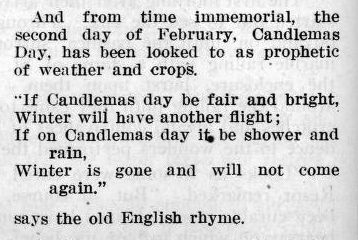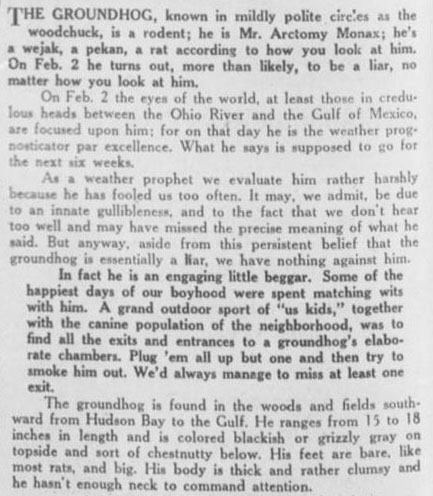The Second Month, The Second Day: Groundhog Day

By the time you read this, Buckeye Chuck will have emerged from his burrow in Marion, Ohio, to predict the timing of spring’s arrival. If he saw his shadow, we can take it as a sign that spring weather is still six weeks away. No shadow? Spring is here, at least according to Chuck. But where did this tradition come from, and how did the groundhog come to be seen as a weather expert?
The first Groundhog Day was celebrated in 1887 at Gobbler’s Knob in Punxsutawney, Pennsylvania. Its roots, however, are found in the observance of Candlemas, an ancient Christian tradition when clergy would bless and distribute the candles needed for winter; in fact, like Groundhog Day, Candlemas is observed today, February 2, in Christian churches around the world. The predictions for winter surrounding Candlemas are:
If Candlemas day be dry and fair/ The half o’ winter’s to come and mair/ If Candlemas day be wet and foul/ The half o’ winter’s gane at Yule

In other words, as with Groundhog Day, a sunny Candlemas predicts six more weeks of winter, but bad weather on Candlemas is proof that winter is nearly over, with its midpoint having come and gone at Yule, which falls on the winter solstice.
As traditions do, those for Candlemas morphed as they spread, eventually adding observations of hibernating animals to the predictions on the arrival of spring. Germans focused on the hedgehog, believing that if it observed its shadow when it exited its den, spring would be slower to arrive. When, upon arriving in Pennsylvania, German immigrants found no hedgehogs, they instead watched groundhogs, of which there were many. It is no surprise, then, that the Pennsylvania groundhog, Punxsutawney Phil, is the most famous of all the weather-predicting rodents, with numerous television appearances, a national following, and even a movie to his name.
Ohio’s own Buckeye Chuck made his first appearance on the weather-predicting scene in the 1970s. He will make his appearance on February 2, predicting the weather for Ohio. In the wild, groundhogs will remain in full hibernation from October until March or April.

Groundhogs have an uneven record for predicting the arrival of spring weather, though this varies, unsurprisingly, from groundhog to groundhog. Buckeye Chuck, for example, holds a 75% accuracy rate, according to his biography on his Facebook page, while Punxsutawney Phil has only been right about 39% of the time, according to an article in Live Science (link to external site). In fact, according to this 2013 article in the Amherst News-Times (found on page 16), Punxsutawney Phil’s record is on par with that of weather-predicting groundhogs across the nation, so perhaps Buckeye Chuck is a miraculous anomaly!
The folks at the Ohio State News weren’t buying that argument in February 1947 (page 10) when they announced a “persistent belief that the groundhog is essentially a liar” due to him having fooled them too often. That being said, they admit that this may be “due to an innate gullibleness [sic], and to the fact that we don’t hear too well and may have missed the precise meaning of what he said.” They go on to call him an “engaging little beggar,” so one can safely say that, although the groundhog may be a liar every February 2, we like him anyway, and will keep checking in to learn his predictions. As of this writing, Groundhog Day is still a few days away. No matter what the groundhog says, spring is right around the corner, and that’s something to celebrate… perhaps with a viewing of “Groundhog Day”?
Thank you to Shannon Kupfer, Digital Initiatives Librarian at theState Library of Ohio, for this week’s post!



Leave a Reply
You must be logged in to post a comment.